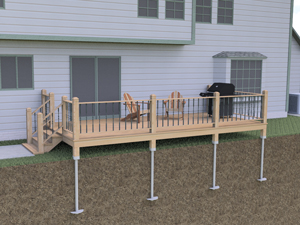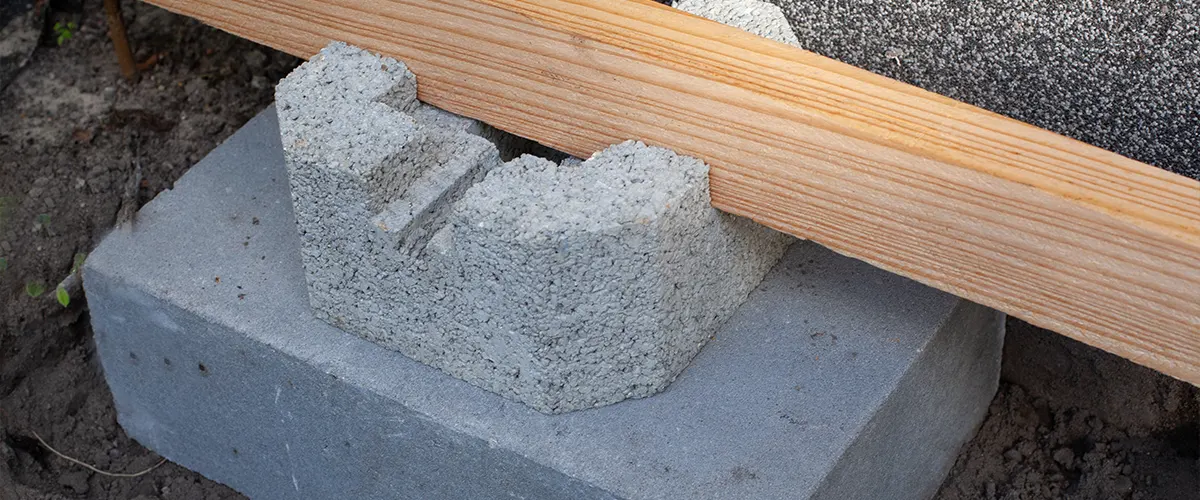Choosing the Right Deck Footings for Security and Durability
The durability and safety of your deck depend greatly on the kind of footings you pick, as they supply the necessary assistance and security to endure the examination of time. In this discussion, we will certainly check out the different kinds of deck grounds, think about the crucial aspects to weigh when making a choice, and dive into the pros and disadvantages of various alternatives.
Sorts Of Deck Grounds
These grounds are composed of a cylindrical opening filled up with concrete, which provides a solid foundation for the deck messages. Concrete pier grounds are fairly very easy to set up and offer superb security, making them a prominent selection for numerous deck projects.
These grounds are set up by screwing them into the ground, which produces a protected structure for the deck. They also allow for easy change and progressing of the deck if needed.
Alternatively, some contractors decide for precast concrete grounds. These footings are made from long lasting concrete and come in numerous shapes and sizes to fit various deck layouts. Precast concrete footings are hassle-free to mount and offer a secure base for the deck framework.
Finally, one more alternative is the post-in-anchor footing system. This sort of ground involves driving a metal support right into the ground and attaching it to the deck post. It offers flexibility in regards to placing the deck blog posts and is appropriate for decks with lightweight frameworks.
When picking the appropriate kind of deck ground, it is vital to take into consideration aspects such as dirt conditions, deck tons, and neighborhood building regulations (Deck Footings). Consulting with a specialist contractor or structural engineer can help make certain the appropriate ground is picked for a steady and secure deck
Variables to Consider When Selecting Footings
When selecting the ideal footings for a deck, it is vital to meticulously take into consideration numerous factors such as dirt problems, deck load, and adherence to local building codes. These aspects play a considerable role in ensuring the stability and longevity of the deck structure.
The kind of dirt on which the deck will be built identifies the type of grounds called for. On the other hand, decks constructed on clay or large dirts may require grounds that can fit the dirt's propensity to broaden and contract.
An additional vital aspect is the deck lots. The weight of the deck, including the materials made use of and any type of prospective live loads such as furnishings or events, should be considered when picking grounds. The footings must be made to bear the weight of the deck and disperse it uniformly to avoid any architectural problems or failures.
Last but not least, adherence to local building regulations is vital. Building ordinance differ from region to area, and it is important to follow the particular requirements established by the local authorities. Deck Footings. These codes make certain that the deck is built securely and satisfies the essential requirements for architectural integrity and load-bearing capacity
Concrete Grounds: Advantages And Disadvantages

Concrete grounds supply numerous benefits and downsides when made use of as the structure for a deck. On the favorable go to my blog side, concrete grounds supply exceptional stability and longevity.
Another benefit of concrete grounds is their convenience. They can be put right into various forms and dimensions to fit different deck designs and arrangements. Concrete footings can be customized to fit the specific needs and needs of the deck framework.
Nevertheless, there are also some downsides to utilizing concrete footings. This can raise the general price of the deck job and may call for expert assistance.

Helical Piers Vs. Sonotubes: Which Is Better?
In thinking about the foundation choices for a deck, the comparison in between helical piers and sonotubes is essential in determining the superior selection. They are twisted right into the ground making use of hydraulic machinery, offering a stable and sturdy structure for the deck.
When it involves stability and toughness, helical piers have the upper hand. The helical plates on the piers develop a solid grasp with the soil, changing or stopping any motion of the deck. This is specifically advantageous in locations with unpredictable or moving dirt conditions. Sonotubes, on the other hand, rely exclusively on the concrete filling for security, which might not offer the very same degree of strength and resistance.
In terms of setup, helical piers are fairly less complicated and faster to mount compared to sonotubes. The hydraulic machinery used to turn the piers into the ground guarantees a efficient and fast process. Sonotubes, on the other hand, require excavating openings and putting concrete, which can be time-consuming and labor-intensive.
Additionally, helical piers are an even more versatile choice. If needed, they can be used in numerous dirt conditions and can be readjusted or reinforced. Sonotubes, on the various other hand, may require added support, such as link rebar, in specific soil conditions or locations with high lots requirements.
Picking the Right Footings for Your Deck's Dimensions
For ideal structural honesty, it is necessary to very carefully choose the suitable grounds that line up with the dimensions of your deck. The measurements of your deck, including its width, elevation, and size, play a considerable function in establishing the type and size of grounds needed.
When choosing footings for your deck, it is vital to take into consideration the load-bearing ability of the soil. The weight of the deck, combined with the weight of any kind of furnishings or individuals on it, applies a substantial force on the footings (Deck Footings). It is crucial to choose footings that can effectively support this weight without moving or sinking over time.
The size and form of the footings should also be considered. Bigger decks with higher dimensions call for bigger footings to supply adequate stability and assistance. The shape of the footings, whether they are square or round, relies on the design and design of the deck. Furthermore, the deepness at which the grounds are mounted need to be identified based upon the frost line in your region to prevent any kind of heaving or moving as a result of freezing temperature levels.
Verdict
Finally, picking the ideal deck grounds is critical for ensuring security and sturdiness. Factors such as the kind of grounds, the deck's dimensions, and the benefits and drawbacks of different alternatives ought to be taken into consideration. Concrete footings use toughness and durability, yet may be a lot more expensive and lengthy to install. Helical piers and sonotubes have their very see this here own advantages and downsides. Inevitably, selecting the proper grounds for your deck's specific requirements is necessary for a long-lasting and successful structure.
These footings consist of a cylindrical hole filled with concrete, which offers a solid foundation for the deck messages. Concrete pier footings are relatively easy to install and provide outstanding stability, making them a prominent option for lots of deck jobs.
Precast concrete grounds are practical to set up and supply a stable base for the deck structure.
It provides flexibility in terms of placing the deck blog posts and is ideal for decks with light-weight structures.
Concrete footings provide a number of advantages and drawbacks when used as the foundation for a deck.